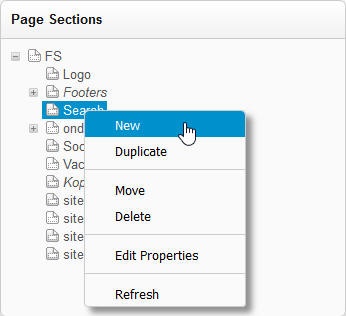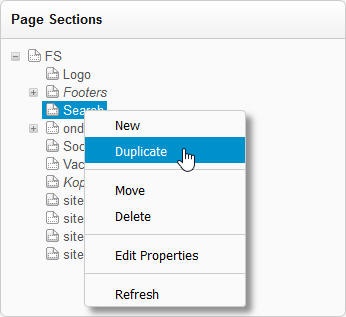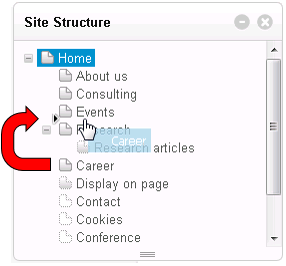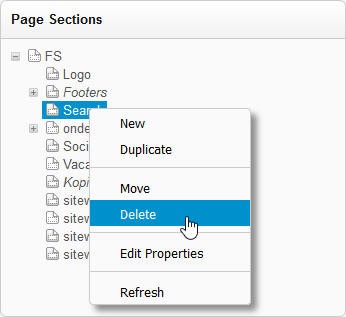Application managers and main editors: Before you can assign page sections to pages and display them, you must perform the steps described in the topic Page Sections.
The Page Section widget is used to create and manage the page sections for your website. The arrangement of pages in the Page Section widget (parent and child pages) helps you to manage and categorize page sections which is especially useful when your website contains dozens of them. In the Page Section widget, you can create, duplicate, move, and delete pages and their child pages. New page sections can also be created using the Create Content drop-down at the top of the sidebars.
In This Topic
Creating a Page Section
All new pages that you create using the Site Structure Widget are child pages of the "Home" page. The "Home" page is at the highest level of the tree and is the only page at that level. To create a new page for your site, follow these steps:
- In the navigation tree in the Page Section Widget, right-click the page section underneath which you want to create the new one.
- Select "New" from the Context menu:
e
The new page section appear as a child page underneath the page that you right-clicked, By default, the name of the new page section is "New Page Section" and its workflow state is "Planned". Select the new page section in the site structure to add content to it. Use the Editor to add content to the new page section. Use the Properties Widget or the Actions Menu in the Editor to modify the properties of the new page section.
Duplicating a Page Section
In the Page Section Widget, you can duplicate a page quickly and easily in one operation. It is also possible to duplicate a page and all its child pages. If a page has multiple versions, only the active version is duplicated. All content appearing on the page section is duplicated as are all its properties. The only difference is that the duplicate page section(s) are in the "Planned" state instead of "Published". If your website supports multiple languages, the duplicated page section(s) will be created in all the available languages.
When you duplicate a page section, the duplicate appears at the bottom of the current tree/subtree on the same level as the original page section. The new page section will be given the title "Copy of <name>".
To duplicate a page section, follow these steps:
- Right-click the page section that you want to duplicate.
- Select "Duplicate" from the Context menu:
A duplicate of the page section will appear at the bottom of the subtree to which the original page section belongs. You can now select the duplicated page in the site structure and modify its content.
Moving a Page Section
In the Site Structure Widget, you can easily move a web page from one location in the navigation tree to another using drag and drop or via the "Context" menu. If the page has child pages, they will be moved to the new location under the parent page. The page you want to move can be dragged and dropped anywhere in the navigation tree under the "Home" page.
Moving a Page Section Using Drag and Drop
To move a page in the navigation tree using drag and drop, hover the mouse pointer over the page and then click the left mouse button and keep it depressed. Drag the page to the location in the tree where you want to drop it. An arrow indicator appears at the location(s) where you can drop the page. If you drag the page over a page with child pages, the subtree will open and show the child pages. When you reach the point where you want to drop the page, let go of the left mouse button. The page is moved to that location. You can also drag a page on top of another page and the moved page will become a child page of the parent. For example:
Moving a Page Section Using the Context Menu
To move a page section using the Context menu, follow these steps:
- Hover the mouse over the page that you want to move and then click the right mouse button. The Context menu appears.
- Select "Move".
- Click [Search] to search for the page under which you want to move the page or click [Show all pages].
- Select the page from the results list and then click [Apply]. The page is moved under the selected page. If the page you move has child pages, they will be moved along with the parent page to the new location.
Deleting a Page Section
In the Page Sections Widget, you can delete a page and all its versions at once. This includes all language versions as well. You can also delete a page and all its child pages in one operation.
To delete all versions of a page simultaneously, follow these steps:
- In the navigation tree, right-click the page section that you want to delete.
- Select "Delete" from the Context menu:
- A warning message will appear asking you to confirm whether you want to delete the page section including all its versions.
- Click [OK]. All versions of the page in all languages are deleted.
Page Section Status
In the Page Sections Widget, you can visually see the status of pages on your website. The following table explains the icons used to indicate the state of page sections in the widget.
Icon | Description |
|---|---|
(normal text) | The page section is in a published state and may be edited. |
(italic text) | The page section is in an unpublished state and may be edited. |
| You do not have permission to edit this page section. | |
| A remark has been added to the page section (see Properties). | |
| The page section exists in another language but there is no version for it in the current language. |
The icons shown above are the ones most often seen in XperienCentral. The rest of the icons not shown in the table above are combinations of the states described.
Language Versions
When more than one language version of your channel exists, you can quickly and easily switch between the versions using the Language drop-down in a sidebar header or using Language Widget in XperienCentral versions R31 and lower. When multiple language versions of pages exist parallel to each other, the page structures are identical, but the title of the pages can be different as well as the workflow status.







